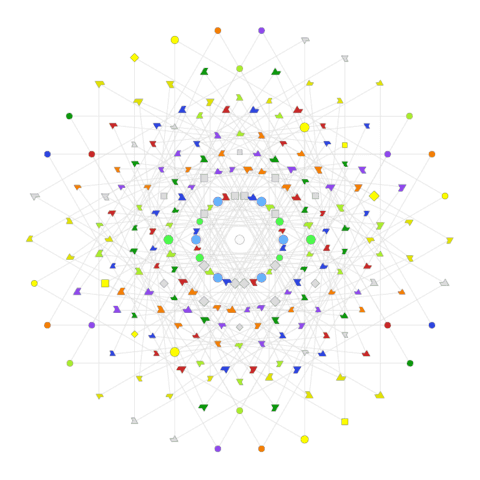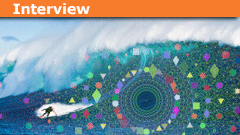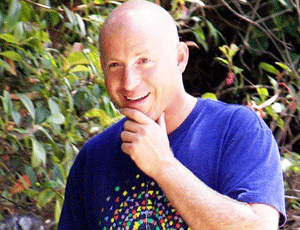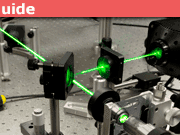Interview with Theoretical Physicist Garrett Lisi
We are pleased to introduce you to Theoretical Physicist and PF Member Garrett Lisi. Known for riding waves and developing a unique theory of everything. Read on!
Table of Contents
 Tell us a little bit about growing up in San Diego
Tell us a little bit about growing up in San Diego
The part of San Diego where I grew up — Rancho Santa Fe — was pretty idyllic. I had a fairly normal, happy childhood. Although I was an introverted kid, and spent a lot of time reading, playing with legos, riding my bike around — and then a lot of time playing with and programming computers, after my father brought one home. It seemed like most of the best things I learned were outside of school, such as while playing games with friends. Then I went to Santa Barbara for boarding school, and academic life got more intense.
With so many waves to get your attention what drew you to physics?
Surfing is extremely fun, but it can’t be all one does. During high school I had the usual adolescent questions about what this universe is, and our part in it. My reading on this took me through a lot of philosophy, and then popular physics… where I learned that mathematics is the “secret” language underlying how our universe operates. I had always been good at math, so to find out that math is the key to understanding what the universe is, through physics… was fantastic, and I’ve been hooked on that ever since.
What is your best surf story/adventure?
The one I’m on now! Living in Maui is pretty fantastic. The water is warm and beautiful, and we have lots of waves and wind — this place is a wonderful playground. And I especially enjoy having friends and other scientists out to visit, and introducing them to this place.
Has your pursuit of adventure sports influenced how you approach physics (vice-versa)?
I’m not sure, but I suspect going out and playing a lot allows me to have more mental flexibility when tackling hard problems. There are times when you hit a wall, working on a tough problem, and nothing you try works. By throwing yourself into a different intense experience for a couple hours, you’re able to come back and think about the problem with a fresh perspective and come up with a new approach that you might not have thought of if you had kept searching along previous lines.
How have you managed to stay productive in a competitive environment while maintaining a work/life balance?
It’s complicated. Playing outside, and spending time with people, and on other projects, keeps me happy enough that I can devote most of my intellectual energy and effort to working on physics — which is something that is also rewarding, but much much harder. There is also a certain amount of competition in physics, I suppose, but I don’t feel it very strongly. From my perspective, you have to understand, most other theoretical physicists are searching along the wrong paths. String theorists should have abandoned strings and supersymmetry and tried other models decades ago. And even within the LQG community, only a handful of people have thought about geometric descriptions of particles and the Standard Model. Every once in a while I see a blip on the radar — such as Chamseddine’s recent paper (http://arxiv.org/abs/1602.02295). But, you know, that’s the closest recent work to mine, and they’re at least ten years behind. I know that sounds arrogant. It’s also possible that I am completely wrong.
How did the publishing of the E8 Lie group change your professional life?
The E8 Lie group was discovered by Killing about 120 years ago… but I presume you mean the E8 Theory paper I put out in 2007? All the attention after that was a very mixed bag. I got invited to do bizarre and cool things, like heliskiing, and making a tv show — which were fun but distracting. And I got lots of criticism, including some rather mean-spirited attempts to discredit me and my work, from the likes of Motl and Distler, which was annoying, and professionally harmful. Since I’d been working largely on my own, along a research direction foreign to the rest of the community, I didn’t have much community support, and I think most physicists looked at the hype and criticism and figured my work couldn’t be any good. Maybe that will end up having been true — but I certainly don’t think so. My life now has been getting back to a more normal cycle of surfing and physics, which is how I like it.
What is the current state of E8 Lie group and what are you working on at the moment?
The main discovery that I was very happy about, back in 2007, was that the mathematical structure of fermionic spinors could be described algebraically by E8 and other exceptional Lie algebras. A more recent discovery I’m excited about, which I described in the Lie Group Cosmology paper (http://arxiv.org/abs/1506.08073), is how to understand anti-commuting, fermionic degrees of freedom geometrically within this context. Basically, spacetime is embedded within a deforming Lie group, and the physical anti-commuting Grassmann fields are 1-form fields orthogonal to spacetime. With this missing piece, I now feel much better about the geometric description of Standard Model fermions. The main problem remaining is how triality works to relate the fermion generations and produce their masses. Towards this, for the past few months I’ve been working with the octonions and split-octonions as they relate to triality, which has been very fun.
If you could collaborate with 5 physicists dead or alive on E8 Lie group etc who would they be?
I have talked productively with several mathematicians, and a few other established physicists, but I think what I’d most like is to talk more with students and postdocs who are interested in the same research directions I am. The line of research I’m following — especially the geometric description of fermions — is very rich, and it’s been hard for me to follow up on all the interesting possibilities. Getting some younger eyes on the topic would probably be productive.
Tell us a little about your Science Hostel idea and if there are any plans for one?
More than plans! The Pacific Science Institute (http://www.pacificscienceinstitute.org) has been open and operating for a year now, with a steady stream of visiting scientists, students, and friends. We’ve had about 60 people come out to Maui, stay in our guest cabins, and enjoy the island and atmosphere here.
What physics research besides your own are you most interested in?
There’s been a ton of fantastic recent progress in experimental physics, as well as other branches of science. The most recent is the triumph of AlphaGo, which is a huge step forward for AI. And the use of CRISPR in bioengineering has amazing potential. And in physics, the detection of gravitational waves by LIGO was a great achievement. There’s also a lot going on in particle physics, with the LHC seeing an intriguing 750GeV bump, and a lot of important fundamental details coming to light about neutrinos.
What does the near/far future hold for Garrett Lisi?
Mostly more physics, surfing, and kitesurfing. I’ve also been very much enjoying my role here as Director of the Pacific Science Institute. It’s been great to have old and new friends come out to Maui, and I’ve enjoyed the conversations, and taking folks out to play around the island. I think I may do this for awhile. Perhaps branching out into other locations.
Lastly, what are some of your all time favorite books, movies, musicians etc?
For that you should friend or follow on Facebook.
To learn more about Garrett Lisi and his E8 Theory please visit his homepage here: http://sifter.org/~aglisi/
Read the next interview for Carlo Rovelli
I have a BS in Information Sciences from UW-Milwaukee. I’ve helped manage Physics Forums for over 22 years. I enjoy learning and discussing new scientific developments. STEM communication and policy are big interests as well. Currently a Sr. SEO Specialist at Shopify and writer at importsem.com


 Tell us a little bit about growing up in San Diego
Tell us a little bit about growing up in San Diego






Nice header logo for the article! It makes use of my artwork based on a (slightly) modified Lisi model for particle assignments within E8. I too use it as a header image for my online presence. http://theoryofeverything.org/theToE/
I have yet get to Hawaii, but when I do, I'm heading straight for PCI!
Garrett looks like Vin Diesel in that pic!Nice interview.
"Tell us a little bit about growing up in San Diego"I have a pretty similar history of the surf sport as Garrett according to this post. I grew up in Ventura in the late 70's and in middle school got turned on to surfing where I surfed mostly at this place called "surfer's point" which was down by the Ventura pier. I then went to high school in Hawaii (Oahu) where I surfed pretty much every break on the Island at one time or another. I also surfed breaks on the Big island during a family vacation and on Kauai when I was picked to represent my HS in the state golf championship. Later on after HS I surfed a few breaks on a trip to Maui I took but the surf wasn't so great that week. I spent most of the time in Lahaina bars working on my bar tan.After HS I went to undergraduate school at UCSB in Santa Barbara. I'm sure Garret is familiar with "campus point" right there by the lagoon on campus and, of course Rincon just a ways south. Also, off the campus of UCSB is a shore break called "sands" beach which is typically a close-out but if the swell is right it can be righteous, dude.Finally, I also lived in San Diego down by the pier in Ocean beach during the mid-90's for a while while I was finishing up a degree at SDSU. So I'm also familiar with most of the breaks in the San Diego area as well as many in Baja on a few trips we took down there in the 80's where we usually got extorted by the Federalies. And that was back when it was calm in Mexico! I'm sure Garrett is familiar with many of the breaks I'm referring to here.Has your pursuit of adventure sports influenced how you approach physics (vice-versa)?While Garrett was probably struggling with understanding the wave functions of quantum mechanics, I was struggling with understanding the wave dynamics of chaotic oscillations in the neocortex as they related to behavior and cognition in mammals. I always thought that my experienced with surfing, especially in my formative years when I was building primary neuro-repertoires REALLY helped me in this pursuit. Sitting out in the surf for hours upon hours a day (sometimes 8 hours or more), which I used to do in high school, you really get built into your biology the kinesthetic and proprioceptic sense of wave dynamics built into your neural assemblies, which I believe affect the efficacy as to how well you can understand wave dynamics intuitively. For example, at many breaks you don't just run into the surf from the sandbar, you have to have to stand at the edge of a cliff and wait for a wave to come in and time it perfectly in order to not get killed. Even if you did time it right you typically got caught in a major cross-current where you really got the message of what a standing wave felt like. You can also get this effect off of a steep sandbar but it's not really the same as when you get caught in a cove on a big surf day. In the cove you're being hit from multiple sides at once, and I truly think that gave me an advanced intuitive sense of how standing wave dynamics work over someone that didn't surf.